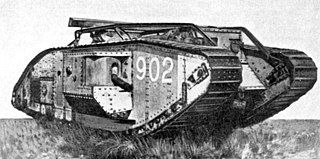
An armoured fighting vehicle (AFV) is an armed combat vehicle protected by armour, generally combining operational mobility with offensive and defensive capabilities. AFVs can be wheeled or tracked. Tanks, armoured cars, assault guns/armoured self-propelled guns, infantry fighting vehicles and armoured personnel carriers (APC) are all examples of AFVs.

Mechanized infantry are infantry units equipped with armored personnel carriers (APCs) or infantry fighting vehicles (IFVs) for transport and combat.

A tank is an armored fighting vehicle intended as a primary offensive weapon in front-line ground combat. Tank designs are a balance of heavy firepower, strong armor, and good battlefield mobility provided by tracks and a powerful engine; usually their main armament is mounted in a turret. They are a mainstay of modern 20th and 21st century ground forces and a key part of combined arms combat.
Military tactics encompasses the art of organizing and employing fighting forces on or near the battlefield. They involve the application of four battlefield functions which are closely related – kinetic or firepower, mobility, protection or security, and shock action. Tactics are a separate function from command and control and logistics. In contemporary military science, tactics are the lowest of three levels of warfighting, the higher levels being the strategic and operational levels. Throughout history, there has been a shifting balance between the four tactical functions, generally based on the application of military technology, which has led to one or more of the tactical functions being dominant for a period of time, usually accompanied by the dominance of an associated fighting arm deployed on the battlefield, such as infantry, artillery, cavalry or tanks.

In military operations, reconnaissance or scouting is the exploration of an area by military forces to obtain information about enemy forces, terrain, and other activities.

A combat engineer is a type of soldier who performs military engineering tasks in support of land forces combat operations. Combat engineers perform a variety of military engineering, tunnel and mine warfare tasks as well as construction and demolition duties in and out of combat zones.
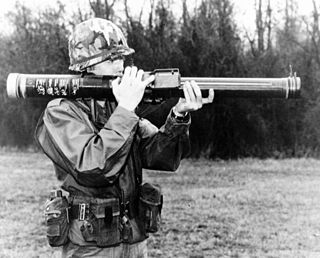
Anti-tank warfare originated from the need to develop technology and tactics to destroy tanks during World War I. Since the Triple Entente developed the first tanks in 1916 but did not deploy them in battle until 1917, the German Empire developed the first anti-tank weapons. The first developed anti-tank weapon was a scaled-up bolt-action rifle, the Mauser 1918 T-Gewehr, that fired a 13mm cartridge with a solid bullet that could penetrate the thin armor of tanks of the time and destroy the engine or ricochet inside, killing occupants. Because tanks represent an enemy's greatest force projection on land, military strategists have incorporated anti-tank warfare into the doctrine of nearly every combat service since. The most predominant anti-tank weapons at the start of World War II in 1939 included the tank-mounted gun, anti-tank guns and anti-tank grenades used by the infantry, as well as ground-attack aircraft.
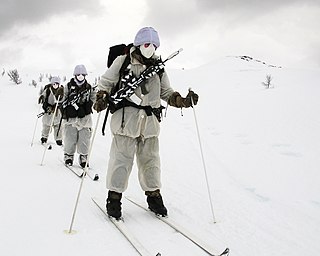
Cold-weather warfare, also known as arctic warfare or winter warfare, encompasses military operations affected by snow, ice, thawing conditions or cold, both on land and at sea. Cold-weather conditions occur year-round at high elevation or at high latitudes, and elsewhere materialise seasonally during the winter period. Mountain warfare often takes place in cold weather or on terrain that is affected by ice and snow, such as the Alps and the Himalayas. Historically, most such operations have been during winter in the Northern Hemisphere. Some have occurred above the Arctic Circle where snow, ice and cold may occur throughout the year. At times, cold or its aftermath—thaw—has been a decisive factor in the failure of a campaign, as with the French invasion of Russia in 1812, the Soviet invasion of Finland in 1939, and the German invasion of the Soviet Union during World War II.

The Multi-Mission Unmanned Ground Vehicle, previously known as the Multifunction Utility/Logistics and Equipment vehicle (MULE), was an autonomous unmanned ground combat vehicle developed by Lockheed Martin Missiles and Fire Control for the United States Army's Future Combat Systems and BCT Modernization programs. The last component of the program was canceled in July 2011.

"Rhino tank" was the American nickname for Allied tanks fitted with "tusks", or bocage cutting devices, during World War II. The British designation for the modifications was Prongs.

2nd Light Armored Reconnaissance Battalion is a fast and mobilized armored terrestrial reconnaissance battalion of the United States Marine Corps. Their primary weapon system is the 8-wheeled LAV-25 and they fall under the command of the 2nd Marine Division and II Marine Expeditionary Force. The unit is based out of the Marine Corps Base Camp Lejeune, North Carolina. The current mission statement of the battalion is: To perform combined arms reconnaissance and security missions in support of the Ground Combat Element (GCE) of a Marine Air-Ground Task Force (MAGTF). Its mission is to conduct reconnaissance, security and economy of force operations, and, within its capabilities, limited offensive or defensive operations that exploit the unit's mobility and firepower.
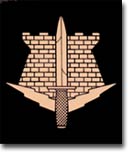
The Singapore Combat Engineers (SCE) is a formation of the Singapore Army. Combat Engineers provide mobility by bridging gaps and clearing minefields to facilitate speedy advance of troops into enemy territory, and counter-mobility by constructing obstacles such as anti-tank ditches to impede the enemy's movement. The Combat Engineers also construct trenches, drainage systems and other related infrastructure to enhance the survivability of troops during operations.
Reconnaissance, surveillance, and target acquisition (RSTA) refers to a joint doctrine of reconnaissance, surveillance and target acquisition conducted by the United States Armed Forces. RSTA operations are designed to support military operations at a strategic, operational, or tactical level, either by dedicated RSTA forces or those which possess the capability.
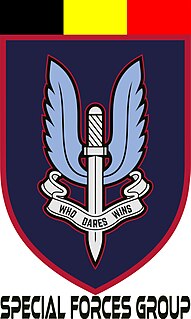
The Special Forces Group is the special forces unit in the Land Component of the Belgian Armed Forces.
Mobility in military terms refers to the ability of a weapon system, combat unit or armed force to move toward a military objective. Combat forces with a higher mobility are able to move more quickly, and/or across more hostile terrain, than forces with lower mobility.
Vehicle recovery is a type of military operation conducted to extricate wheeled and tracked vehicles that have become immobile due to condition of the soil, nature of terrain in general, loss of traction due to an attempt to negotiate an obstacle, having broken down, or from sustaining non-combat or combat damage. Vehicles used in military operations can be hard to extricate from sand, snow, or mud.
Route reconnaissance is the intelligence assessment of the operational environment in reconnaissance operations of routes for military use, including methods of reconnoitering and classifying them for other troops. In a tactical area of responsibility during combat operations the primary purpose of conducting route reconnaissance is to find and report all enemy forces that can interfere with movement along a route, and to identify the limit of direct-fire range and terrain that dominates the route.
The reconnaissance mission within the United States Marine Corps is divided into two distinct but complementary aspects; Marine Division Recon and Force Reconnaissance.

A reconnaissance vehicle, also known as a scout vehicle, is a military vehicle used for forward reconnaissance. Both tracked and wheeled reconnaissance vehicles are in service. In some nations, light tanks such as the M551 Sheridan and AMX-13 have also been used by scout platoons. Their armament ranges from a medium machine gun to a large cannon. Modern examples are often fitted with ATGMs and a wide range of sensors.













